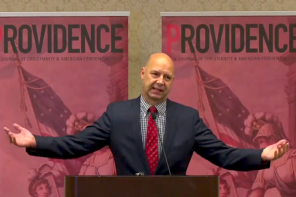On Good Friday, Wall Street’s Trinity Church in New York employed microblogging to recreate Christ’s final hours in a Twitter enactment of the Passion Play. Over a period of three hours, followers of twspassionplay received frequent updates of 140 characters or fewer from the main characters: Mary, Joseph, a serving girl, Peter, Pontius Pilate and, of course, Jesus, whose tweets included: “Let the scriptures be fulfilled,” “It is as the prophets wrote,” “I am who you say I am,” and “it is as the prophets have written: I tell my tale of misery while they look on and gloat.”
The church described “what may be the world’s first Passion play performed through… Twitter,” as a “unique Passion Play that marries this timeless Christian tradition with the latest in social networking trends.” But has blogging been redeemed for sacred communication this holy week?
The site’s commenters thought so, positively raving about this new use of microblogging. One follower wrote that it was a “moving experience,” while another wrote: “really good and really immediate—never had Passion story so much a part of real life before.” One even wrote: “…I have to say I am proud of technology today.”
In a previous article, I wrote about Twitter converts, who are enthusiastically developing in-tweet content and symbols to spur sharing, replicating, and searching of faith-related content online; believers can now “tweet without ceasing” as they observe regular rhythms of prayer and intercessions. Twittering the Passion Play represents one more facet of religious devotion: dramatization expressed via the symbols of online technologies.
This online innovation can be celebrated as a way in which religious organizations encourage fresh personal and media interest in waning rituals, like the observation of Lent and Good Friday. Twitter drama can be utilized for religious community-building, as geographically dispersed followers connect and participate in recreating biblical stories. Yet alternative readings of this twittered enactment also bring up critical thoughts about online faith consumption.
From Pew to Pixel: Consuming Plays Online
In Consuming Religion, Vincent Miller talks about the commodification of religion and the celebrity spectacle supported by mass media. Although he seldom references the specific role of the Internet and new media in creating religious spectacles, he highlights how the practice of privatized faith consumption may both benefit and deform Christianity. The ability of religious organizations to attract media attention may be beneficial for community growth, but the virtual fulfillment of religious sentiments may disorient and blur lines between lived religion and representations of the real.
In this vein, Twitter enactments of the Passion Play can be seen as an online media spectacle that abstracts original elements of the biblical passion account by diluting it into brief re-tweeted messages. Twittering can serve as a symbolic good that bloggers shallowly use to replace local and sustained communal mediation of religious traditions. The concern is that short tweetplays may come to represent an increasingly passive form of religious infotainment that faith believers consume in a Christianity-lite diet—in 140 characters or fewer.
Of course, tweeting religious texts can also affirm religious community-building, depending on how these tweets are integrated into the fabric of religious bodies. Religious leaders can comment by asking readers, who are inspired by tweets, to listen to their sermons online, and to visit their churches. Tweets can also contribute to the religious conversion process by strengthening the weak ties that some seekers have developed online to real life interpersonal attachments.
In the case of Trinity Church, the tweeted Passion Play was part of the larger church programming for Easter, which included both on- and offline dimensions. Visitors to the church’s Web site are notified of multiple religious services but are also invited to explore online “Stations of the Cross,” where they can click on black and white photos of a recent staging of the Stations of the Cross in Manhattan to reveal scriptural passages, prayers, and meditative music. Interestingly, with this digital Stations presentation, user interactivity is elevated to another level online, with enhanced visual and sensory appeals. Media spectacle here is presented as a Web version of the Stations of the Cross, and believers are urged to click and “pray as you go” online.
To be sure, narratives have historically been powerful to satiate human urges for meaning, security, and belonging. Today, the communal nature of religions and intense need for communication endures as online storytelling via twitter and other microblogging sites take on novel applications, and bursts of Passion Plays. Welcome, Digital Good Friday. The world awaits new resurrections of the living word online.




